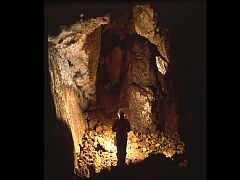Cansiglio


Cansiglio (Canséi or Canséjo in
Geography

The plateau rises immediately above the plain below, at more than 1,000 m (3,300 ft) above the sea level. It is in fact formed by a basin surrounded by rocky peaks, such as Monte Costa, the Cima Valsotta, Monte Millifret, Pizzoc and the Monte Cavallo; these mountains separate the Cansiglio from the short Val Lapisina valley and from Piancavallo.
The plateau features several examples of
Most of the territory of Cansiglio is covered by woods, mostly composed of local
History
Pre-historic remains showed that the area was inhabited since as early as the 8th millennium BC. However, the area is mentioned officially for the first time in a 923 document, a diploma by which emperor
In 1404, together with Belluno, it became part of the Republic of Venice. After the latter's collapse and the period of Austrian dominance, it became a statal property under the Kingdom of Italy (late 19th century).
During World War II Cansiglio was the seat of partisan resistance against the German occupation. After a mop-up operation in late August-early September 1944, which ended with a German-Italian victory, the Bus de la Lum was used as an improvised cemetery for casualties from both sides, as well as of local civilians killed by the Germans after the partisans had escaped.
External links
- Cansiglio website (in Italian)
- Page at the Veneto region website Archived 2013-06-21 at the Wayback Machine (in Italian)
- Website about the Cansiglio Cimbrians (in Italian and English)
